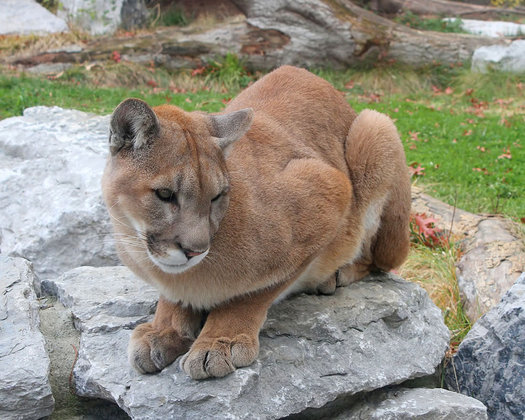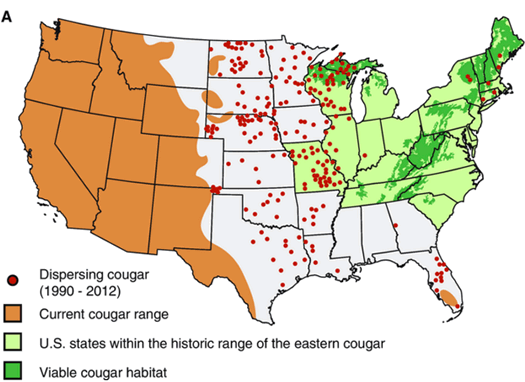But if there were mountain lions here...

For hire? / photo: Greg Hume (CC BY-SA 3.0) via Wikipedia
An interesting thing about the way the landscape of the Northeast has been changing over the last century is that the amount of forested land has actually increased as many areas that were once cleared for farming have fallen back into being covered by trees.
These new forests aren't exactly like the old forests, though. Among the differences: they lack some of the large predators of the past -- notably cougars/mountain lions and wolves. That might not seem like a big deal for humans -- it might even seem like a good thing, considering those sorts of animals can be a bit fear inducing. But one of the side effects is that deer now lack a natural predator, and their populations have exploded.
There are so many deer. And they cause all sorts of problems -- from car crashes, to disease transmission, to habitat destruction, to grazing on gardens.
So. If we could get some of these predators back in this area -- mountain lions, specifically -- what might that be worth?
That's the question at the heart of a recent paper in the journal Conservation Letters by a group of researchers at the University of Idaho, the University of Washington, and other institutions. They modeled what might happen if mountain lions re-established populations in the eastern United States -- and how that might affect the costs associated with car crashes involving deer.
From the paper's abstract:
The decline of top carnivores has released large herbivore populations around the world, incurring socioeconomic costs such as increased animal-vehicle collisions. Attempts to control overabundant deer in the Eastern United States have largely failed, and deer-vehicle collisions (DVCs) continue to rise at alarming rates. We present the first valuation of an ecosystem service provided by large carnivore recolonization, using DVC reduction by cougars as a case study. Our coupled deer population models and socioeconomic valuations revealed that cougars could reduce deer densities and DVCs by 22% in the Eastern United States, preventing 21,400 human injuries, 155 fatalities, and $2.13 billion in avoided costs within 30 years of establishment. Recently established cougars in South Dakota prevent $1.1 million in collision costs annually. Large carnivore restoration could provide valuable ecosystem services through such socio-ecological cascades, and these benefits could offset the societal costs of coexistence.
Yep, more than $2 billion in avoided costs, and more than 21,000 fewer human injuries (and 155 fewer deaths) over 30 years, just from reduced car crashes.
The paper is online and open access if you'd like to read it. The researchers explain how they built their model, and some of the assumptions they made. They write that they tried to be conservative in their estimates -- for example, they assumed that of the deer killed by mountain lions, only 25 percent of them would be deer that wouldn't otherwise be killed off in some other way.
They also break out how much the presence of deer-hunting mountain lions could potentially save in individual states. They estimate that if mountain lions set up shop again (so to speak) in New York their impact on the deer population might, over three decades, result in:
+ More than 72,000 fewer car crashes involving deer
+ $218 million in avoided costs
+ More than 2,100 fewer human injuries
+ 16 avoided human deaths
(There are between 60,000 and 70,000 deer/vehicle crashes each year in New York State, according to the state Department of Transportation.)
Of course, there would be other effects of mountain lions returning to the eastern United States. Some of those would be good -- again, in part because they'd check populations of other animals that cause problems. But some of them wouldn't be good -- sometimes mountain lions eat livestock, or in very rare cases, attack humans. Though as the researchers note: "Yet we estimate cougars would indirectly save far more people from death (5 per year) and injury (680 per year) by reducing [deer-vehicle collisions] than they would likely directly kill (<1 per year) or injure (∼5 per year)."

This map is from the paper by Conservation Letters paper by Sophie Gilbert, Laura Prugh, and a group of researchers.
The eastern mountain lion has been extinct since the 1930s, according to the US Fish and Wildlife Service. Even so, there are many stories of people reporting seeing something that looks a lot like a mountain lion in this part of the country (example: Washington County in 2014). And there are scientists who argue it's just a matter of time until the big cats move here from the west and re-establish their populations. (There was a mountain lion that, somehow, made its way into Connecticut a few years back -- and passed through Lake George on the way.)
The official line is that hasn't happened, yet. But in light of this recent research paper, the hoax notice on the NYS DEC's page about mountain lions in New York takes on a slightly different sound:
False Rumor: DEC Releasing Cougars to Control Deer
Rumors have been circulating for the past few years that the DEC has released cougars to control deer populations. Some of these rumors claim that Officer 'Jones' participated in the release, or that people have actually seen cougars with ear tags or neck collars, so they must have been released by the state. This is not true. The DEC has never released cougars, despite what you may hear to the contrary.
Maybe it's something to think about.
[via @CarlZimmer]
Earlier and elsewhere:
+ Here's an article at Vox from earlier this summer talking with one of the researchers
+ AOA: Where the wild things aren't... yet
Hi there. Comments have been closed for this item. Still have something to say? Contact us.
Comments
If only the Flabby Tabby was more interested in hunting instead of local sightseeing. #neverforget
http://alloveralbany.com/archive/2010/06/07/the-secret-photostream-of-flabby-tabby
But seriously, yes please on introducing large predators back into the region.
... said Jeff M on Sep 22, 2016 at 11:14 AM | link